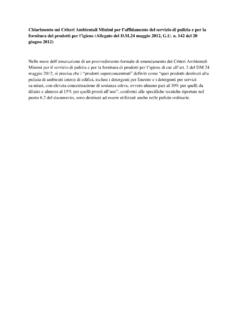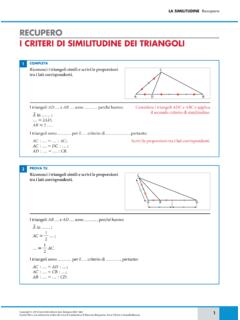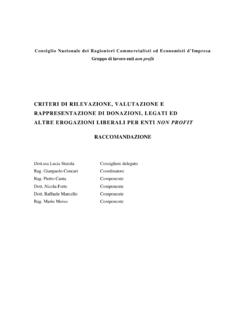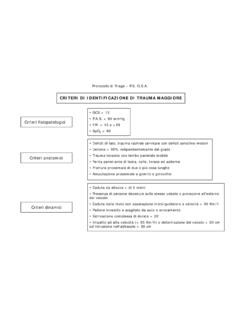Transcription of Basel Committee on Banking Supervision Board of the ...
1 Basel Committee on Banking Supervision Board of the international organization of securities Commissions Consultative document Criteria for identifying simple, transparent and comparable short-term securitisations Issued for comment by 5 October 2017 July 2017 2 Criteria for identifying simple, transparent and comparable short-term securitisations This publication is available on the BIS website ( ). Bank for international Settlements 2017. All rights reserved. Brief excerpts may be reproduced or translated provided the source is stated. ISBN 978-92-9259-072-7 (online) Criteria for identifying simple, transparent and comparable short-term securitisations i Contents Introduction .. 1 Objectives of the short-term STC criteria .. 1 Scope of the short-term STC criteria .. 2 Design of the short-term STC criteria .. 2 Questions .. 6 Feedback to the consultation .. 7 Annex Criteria for identifying simple, transparent and comparable (STC) short-term securitisations.
2 8 Criteria for identifying simple, transparent and comparable short-term securitisations 1 Introduction In July 2015, the Basel Committee on Banking Supervision (BCBS) and the Board of the international organization of securities Commissions (IOSCO) published the final criteria for identifying simple, transparent and comparable (STC) term In July 2016, the BCBS published revisions to its securitisation framework that incorporated the regulatory capital treatment of STC term The purpose of these criteria and associated regulatory capital treatment is to assist the financial industry in its development of STC securitisation structures. As short-term securitisations, typically those using an asset-backed commercial paper (ABCP) conduit to issue forms of commercial paper, differ significantly in structure from term securitisations, the STC criteria published in July 2015 cannot be applied to them without appropriate amendments.
3 During the development of STC criteria for term securitisations, many commenters indicated that it would be useful to extend the scope of the STC criteria to short-term securitisations, in particular exposures related to ABCP conduits. ABCPs are a key part of securitisation markets in some jurisdictions and can provide a significant source of funding to the economy. Similarly to term securitisations, the outstanding volume and issuance of ABCPs dropped significantly following the financial In response to the comments received, BCBS-IOSCO have developed a set of 17 STC criteria specifically catering to short-term securitisations, focusing on exposures related to ABCP conduits (see Annex). The STC criteria for short-term securitisations (hereafter short-te rm STC criteria ) do not serve as a substitute for investor due diligence. The criteria are also non-exhaustive and non-binding. Interested parties may complement these criteria with additional and/or more detailed criteria based on specific needs and applications.
4 BCBS-IOSCO seek comments on the short-term STC criteria presented in this document by 5 October 2017. The BCBS is working in parallel on a proposal to incorporate these criteria into the regulatory capital Objectives of the short-term STC criteria The development of the short-term STC criteria advances the objective of BCBS-IOSCO s work on securitisations to help transaction parties including originators, investors and other parties with a fiduciary responsibility evaluate the risks of a particular securitisation across similar products. For investors, these criteria should assist them with their conduct of due diligence on securitisations, but in no case would these criteria serve as a substitute for such due diligence. Simplicity refers to the relative homogeneity of underlying assets included in each transaction financed by the ABCP conduit, with simple characteristics, and a conduit structure that is not overly complex.
5 Criteria on transparency provide: 1 See 2 See 3 While much of the decline reflects the discontinuation of complex structures such as special investment vehicles (SIVs), asset-backed extensible notes, mortgage warehouse programmes and other market value programmes, it has also extended to the remaining ABCP structures that now make up the majority of the ABCP market (ie multi-seller conduits that invest in traditional asset classes such as trade and credit card receivables, equipment leases, and auto and consumer loans). 4 See 2 Criteria for identifying simple, transparent and comparable short-term securitisations - investors with sufficient information on the underlying assets and underlying transactions, as well as details about the conduit structure and liquidity and credit support received; and - the sponsor with granular information on the underlying assets. Criteria promoting comparability could assist investors in their understanding of such investments and enable more straightforward comparison across similar securitisation products within an asset class.
6 Importantly, they should appropriately take into account differences across jurisdictions. Scope of the short-term STC criteria The short-term STC criteria cover ABCP conduits that primarily finance themselves through the issuance of commercial paper, typically involving one or multiple sellers of assets to the ABCP conduit (often short-term trade receivables). Credit securities arbitrage and structured investment vehicle (SIV) structures,5 where most of the problems occurred during the financial crisis, are excluded from the scope of short-term STC criteria. The short-term STC criteria focus on the characteristics of the ABCP conduit and the underlying transactions and not on the legal form of the instruments issued or used to fund it (eg the ABCP conduit could issue short-term commercial paper or accept loans from lenders secured against the underlying assets/transactions). The short-term STC criteria also do not prevent single-seller conduits6 (which are generally less common) from qualifying for STC status.
7 However, in such an instance, some of the proposed criteria may be less relevant because they have been designed to reflect the dual-layer structure of multi-seller conduits (in particular, the asset risk criteria). Single-seller conduits are often less diversified, and investors should be clearly aware of the risk of concentration. Design of the short-term STC criteria The design of the short-term STC criteria follows the STC criteria published in July 2015 for term securitisations. While all principles underlying the STC criteria for term securitisations are relevant for short-term securitisations, some criteria have been amended to reflect specific aspects of ABCP conduits, in particular: the short maturity of the commercial paper issued by ABCP conduits; the different forms of programme structures (multi-seller, single seller);7 and 5 During the financial crisis, these structures left investors exposed to a very high risk, as they had often little liquidity support and relied on the ability to liquidate the entire portfolio to repay the commercial paper holders in times of stress.
8 Many of these structures have failed as a result, as they did not manage to sell their assets or had to sell them at a high discount rate during the crisis. 6 A single-seller conduit is typically a bank or an auto captive that sells receivables or short-dated assets to a bankruptcy-remote special purpose vehicle which then issues commercial paper secured by these receivables. They typically have a first lost piece to cover defaults that remain with the seller (eg in the form of a letter of credit) and liquidity facility. 7 Some jurisdictions use multi-seller structures in which a conduit typically holds interest from multiple pools of credit claims or receivables from various sellers. These sellers can be non-financial institutions. Criteria for identifying simple, transparent and comparable short-term securitisations 3 the existence of multiple forms of liquidity and credit support facilities on different levels of the ABCP structure (ie conduit level or transaction level).
9 This section describes the key areas considered by BCBS-IOSCO in the design of the short-term STC criteria. 1. Transaction-level and conduit-level criteria One of the main amendments made to the STC criteria for term securitisations was to split the criteria into two categories to reflect the two levels of stakeholders, relevant in ABCP conduits: (i) the sellers, who are typically the original lenders and, potentially, servicers of the underlying assets; and (ii) the sponsor, who establishes or manages an ABCP conduit, and plays an essential fiduciary role in ensuring the quality of the underlying transactions and pools of assets financed by the ABCP conduit. Graph 1 provides a stylised view of a typical ABCP conduit structure and illustrates the various roles that banks may play. Schematic illustration of an ABCP conduit structure Graph 1 As a result, the short-term STC criteria distinguish between criteria relevant at the transaction level and at the conduit level.
10 Most criteria are relevant at both levels, but have a slightly different focus to reflect the differences in risk, stakeholders or structure at each level. For instance, for the criterion on consistency of underwriting (Criterion A4): Transaction-level criteria Seller Obligor(s) Obligor(s) Obligor(s) Seller Seller Conduit-level criteria Investors/ Lenders ABCP conduit Programme-wide credit enhancement Liquidity / credit support Swap / Derivatives counterparty Transaction 1 Transaction 2 Transaction 3 4 Criteria for identifying simple, transparent and comparable short-term securitisations at the transaction level, the sponsor ensures that sellers apply a consistent underwriting standard between the assets transferred to the transaction and those retained on their balance sheet; and at the conduit level, the sponsor makes representation and warranties to investors that it has taken steps to verify that assets financed by the conduit have been subject to consistent underwriting standards.

















